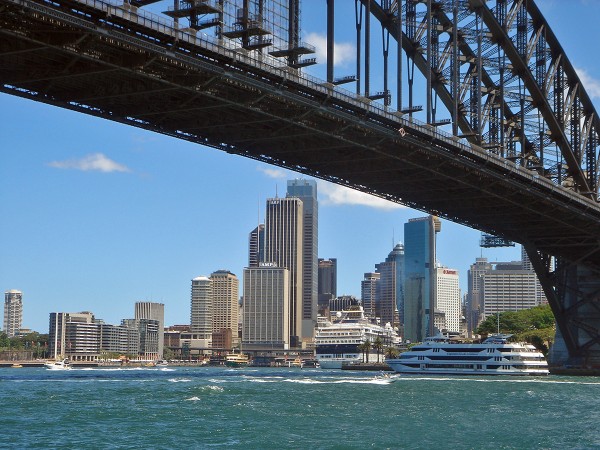 Many of the major industries in Australia are oligopolies/oligopsonies. Examples include banking, telecoms, supermarkets, insurance and iron ore. The dominant firms in these markets have been accused of exploiting their market power, both in charging high prices to consumers and driving down the prices paid to suppliers. The result, it is claimed, is that they have been making excessive profits.
Many of the major industries in Australia are oligopolies/oligopsonies. Examples include banking, telecoms, supermarkets, insurance and iron ore. The dominant firms in these markets have been accused of exploiting their market power, both in charging high prices to consumers and driving down the prices paid to suppliers. The result, it is claimed, is that they have been making excessive profits.
But things may be changing. With the rise of online trading, barriers to entry in these markets have been falling. Many of the new entrants are established firms in other countries and hence already have economies of scale.
The first article below examines the challenge to established oligopolists in Australia.
Articles and blogs
The death of the oligopoly: Australia’s incumbents face new rivals Financial Review (Australia), Michael Smith (21/4/15)
Australian Oligopolies The Grapevine, Adam Dimech (27/12/14)
Paper
Breaking up Australia’s oligopolies Ashurst Australia (14/8/13)
Questions
- Find out which are the major firms in Australia in the five industries identified above. What is their market share and how has this been changing?
- What barriers to entry exist in each of these industries in Australia? To what extent have they been declining?
- What can new entrants do to overcome the barriers to entry?
- What technological developments allow other companies to challenge Foxtel’s pay television monopoly?
- To what extent are developments in the supermarket industry in Australia similar to those in the UK?
- To what extent does Australia benefit from increased globalisation?
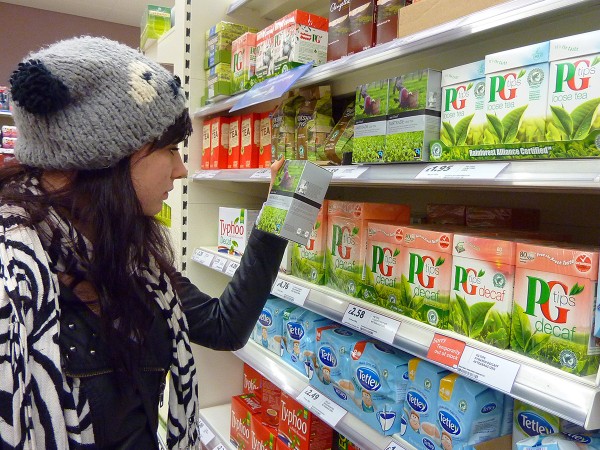 In an earlier post, Elizabeth looked at oligopolistic competition between supermarkets. Although supermarkets have been accused of tacit price collusion on many occasions in the past, price competition has been growing. And recent developments show that it is likely to get a lot fiercer as the ‘big four’ try to take on the ‘deep discounters’, Aldi and Lidl.
In an earlier post, Elizabeth looked at oligopolistic competition between supermarkets. Although supermarkets have been accused of tacit price collusion on many occasions in the past, price competition has been growing. And recent developments show that it is likely to get a lot fiercer as the ‘big four’ try to take on the ‘deep discounters’, Aldi and Lidl.
Part of the reason for the growth in price competition has been a change in shopping behaviour. Rather than doing one big shop per week in Tesco, Sainsbury’s, Asda or Morrisons, many consumers are doing smaller shops as they seek to get more for their money. A pattern is emerging for many consumers who are getting their essentials in Aldi or Lidl, their ‘special’ items in more upmarket shops, such as Waitrose, Marks & Spencer or small high street shops (such as bakers and ethnic food shops) and getting much fewer products from the big four. Other consumers, on limited incomes, who have seen their real incomes fall as prices have risen faster than wages, are doing virtually all their shopping in the deep discounters. As the Guardian article below states:
A steely focus on price and simplicity, against a backdrop of falling living standards that has sharpened customers’ eye for a bargain, has seen the discounter grab market share from competitors and transform what we expect from our weekly shop.
The result is that the big four are seeing their market share falling, as the chart shows. 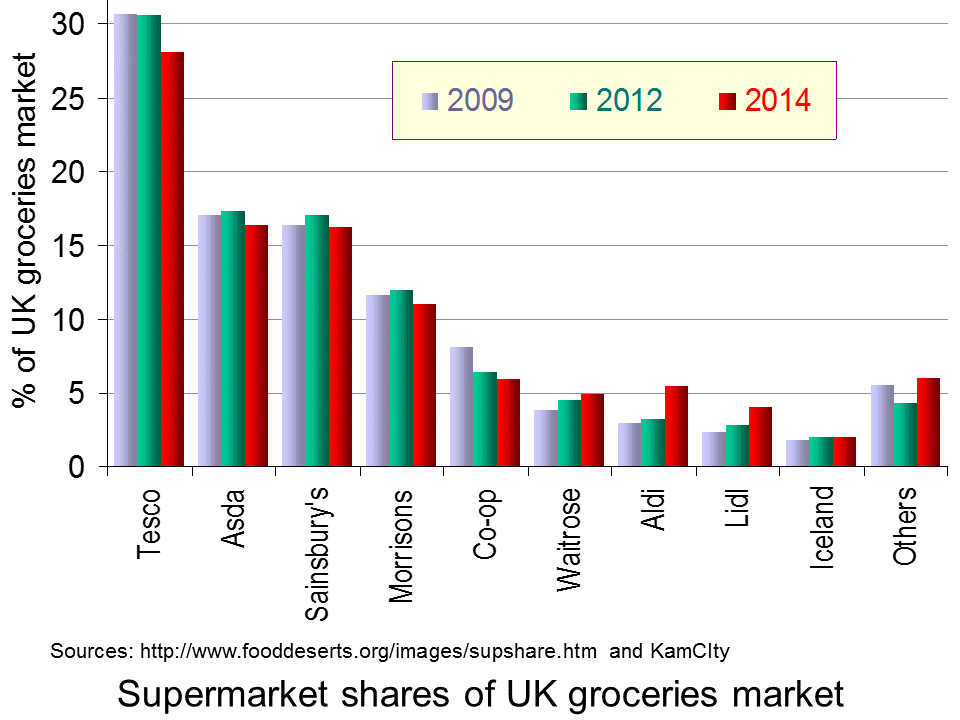 (Click here for a PowerPoint of the chart.) In the past year, Tesco’s market share has fallen from 29.9% to 28.1%, Asda’s from 17.8% to 16.3%, Sainsbury’s from 16.9% to 16.2% and Morrisons’ from 11.7% to 11.0%. By contrast, Aldi’s has risen from 3.9% to 5.4% and Lidl’s from 3.1% to 4.0%, while Waitrose’s has also risen, from 4.7% to 4.9%. And it’s not just market share that has been falling for the big four. Profits have also fallen, as have share prices. Sales revenues in the four weeks to 13 September are down 1.6% on the same period a year ago; sales volumes are down 1.9%.
(Click here for a PowerPoint of the chart.) In the past year, Tesco’s market share has fallen from 29.9% to 28.1%, Asda’s from 17.8% to 16.3%, Sainsbury’s from 16.9% to 16.2% and Morrisons’ from 11.7% to 11.0%. By contrast, Aldi’s has risen from 3.9% to 5.4% and Lidl’s from 3.1% to 4.0%, while Waitrose’s has also risen, from 4.7% to 4.9%. And it’s not just market share that has been falling for the big four. Profits have also fallen, as have share prices. Sales revenues in the four weeks to 13 September are down 1.6% on the same period a year ago; sales volumes are down 1.9%.
But can the big four take on the discounters at their own game? Morrison’s has just announced a form of price match scheme called ‘Match & More’. If a shopper finds that a comparable grocery shop is cheaper in not only Tesco, Sainsbury’s or Asda, but also in Aldi or Lidl, then ‘Match & More users will automatically get the difference back in points on their card. Shoppers also will be able to collect extra points on hundreds of featured products and fuel’. When the difference has risen to a total £5 (5000 points), the shopper will get a £5 voucher at the till. The idea is to encourage customers to stay loyal to Morrisons.
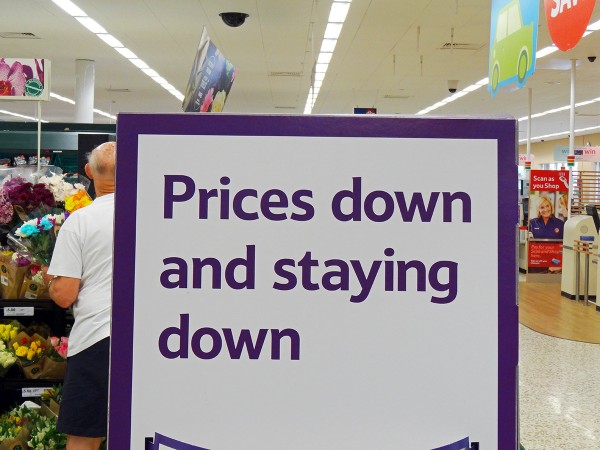 But what if Tesco, Asda and Sainsbury’s do the same? What will be the impact on their prices and profits. Will there be a race to the bottom in prices, or will they be able to keep prices higher than the deep discounters, hoping that many customers will not cash in their vouchers?
But what if Tesco, Asda and Sainsbury’s do the same? What will be the impact on their prices and profits. Will there be a race to the bottom in prices, or will they be able to keep prices higher than the deep discounters, hoping that many customers will not cash in their vouchers?
But if effectively the big four felt forced to cut their prices to match Aldi and Lidl, could they afford to do so? This depends on their comparative average costs. At first sight, it might be thought that the big four could succeed in profitably matching the discounters, thereby clawing back market share. After all, they are much bigger and it might be thought that they would benefit from greater economies of scale and hence lower costs.
But it is not as simple as this. The discounters have lower costs than the big four. Their shops are typically in areas where rents or land prices are lower; their shops are smaller; they carry many fewer lines and thus gain economies of scale on each line; they have a much higher proportion of own-brand products; products are displayed in the boxes they come in, thus saving on the staff costs of unpacking them and placing them on shelves; they buy what is cheapest and thus do not always display the same brands.
So is Morrison’s a wise strategy? Will other supermarkets be forced to follow? Is there a prisoners’ dilemma here and, if so, is there any form of collusion in which the big four can engage which is not illegal? Can the big four differentiate themselves from the discounters and the up-market supermarkets in ways that will attract back customers?
It is worrying times for the big four.
Articles
- Heavy Discounters Up Pressure On The UK’s Big Four Supermarkets
Alliance News, Rowena Harris-Doughty (3/6/14)
- Tesco loses more market share as supermarket sector slows to record low
CITY A.M., Catherine Neilan (23/9/14)
- Record low for grocery market growth as inflation disappears
Kantar World Panel, Fraser McKevitt (23/9/14)
- How Aldi’s price plan shook up Tesco, Morrison’s, Asda and Sainsbury’s
The Guardian, Sarah Butler (29/9/14)
- Sainsbury’s shares drop 7% on falling sales report
BBC News (1/10/14)
- Sainsbury results: the reaction
Food Manufacture, Mike Stones (3/10/14)
- Morrisons Becomes First Of Big Four Grocers To Price Match Aldi, Lidl
Alliance News, Rowena Harris-Doughty (2/10/14)
- UK: Morrisons Takes On Discounters With Price Match Card
KamCity (3/10/14)
- Morrisons to match the prices of Aldi and Lidl
The Telegraph, Graham Ruddick (2/10/14)
- Three reasons why Morrisons price-matching Aldi and Lidl is not a ‘gamechanger’
The Telegraph, Graham Ruddick (2/10/14)
Questions
- Would it be possible for the big four to price match the deep discounters?
- What is meant by the prisoners’ dilemma? In what ways are the big four in a prisoners’ dilemma situation?
- Assume that you had to advise Tesco on it strategy? What advise would you give it and why?
- Assume that two firms, M and A, are playing the following ‘game’: firm M pledges to match firm A’s prices; and firm A pledges to sell at 2% below M’s price. What will be the outcome of this game?
- Is Morrisons wise to adopt its ‘Match & More’ strategy?
- Why is it difficult for Morrisons to make a like-for-like comparison with Aldi and Lidl in its ‘Match & More’ strategy?
- Why may Aldi and Lidl benefit from Morrisons’ strategy?
 Facebook has announced that it’s purchasing the messaging company WhatsApp. It is paying $19 billion in cash and shares, a sum that dwarfs other acquisitions of start-up companies in the app market. But what are the reasons for the acquisition and how will it affect users?
Facebook has announced that it’s purchasing the messaging company WhatsApp. It is paying $19 billion in cash and shares, a sum that dwarfs other acquisitions of start-up companies in the app market. But what are the reasons for the acquisition and how will it affect users?
WhatsApp was founded less than five years ago and has seen massive growth and now has some 450 million active users, 70% of whom use it daily. This compares with Twitter’s 240 million users. An average of one million new users are signing up to WhatsApp each day. As the Wall Street Journal article, linked below, states:
Even by the get-big-fast standards of Silicon Valley, WhatsApp’s story is remarkable. The company, founded in 2009 by Ukrainian Jan Koum and American Brian Acton, reached 450 million users faster than any company in history, wrote Jim Goetz, a partner at investor Sequoia Capital.
Facebook had fewer than 150 million users after its fourth year, one third that of WhatsApp in the same time period.
Yet, despite its large user base, WhatsApp has just 55 employees, including 32 engineers.
For the user, WhatsApp offers a cheap service (free for the first year and just a 99¢ annual fee thereafter). 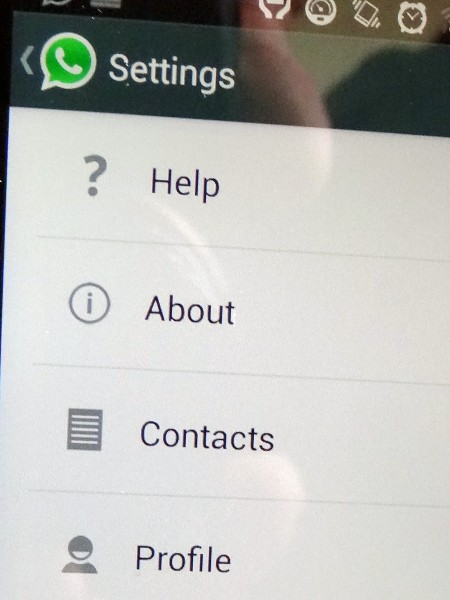 There are no charges for sending or receiving text, pictures and videos. It operates on all mobile systems and carries no ads. It also offers privacy – once sent, messages are deleted from the company’s servers and are thus not available to government and other agencies trying to track people.
There are no charges for sending or receiving text, pictures and videos. It operates on all mobile systems and carries no ads. It also offers privacy – once sent, messages are deleted from the company’s servers and are thus not available to government and other agencies trying to track people.
With 450 million current active users, this means that revenue next year will not be much in excess of $450 million. Thus it would seem that unless Facebook changes WhatsApp’s charging system or allows advertising (which it says it won’t) or sees massive further growth, there must have been reasons other than simple extra revenue for the acquisition.
Other possible reasons are investigated in the videos and articles below. One is to restrict competition which threatens Facebook’s own share of the messaging market: competition that has seen young people move away from Facebook, which they see is becoming more of a social media platform for families and all generations, not just for the young.
Videos and podcasts
 Facebook pays billions for WhatsApp Messenger smartphone service Deutsche Welle, Manuel Özcerkes (19/2/14)
Facebook pays billions for WhatsApp Messenger smartphone service Deutsche Welle, Manuel Özcerkes (19/2/14)
 Facebook’s WhatsApp buy no bargain Reuters, Peter Thal Larsen (20/2/14)
Facebook’s WhatsApp buy no bargain Reuters, Peter Thal Larsen (20/2/14)
 Facebook Agrees To Buy WhatsApp For $19bn Sky News, Greg Milam (20/2/14)
Facebook Agrees To Buy WhatsApp For $19bn Sky News, Greg Milam (20/2/14)
 Facebook Eliminates Competitor With WhatsApp Bloomberg TV, Om Malik, David Kirkpatrick and Paul Kedrosky (20/2/14)
Facebook Eliminates Competitor With WhatsApp Bloomberg TV, Om Malik, David Kirkpatrick and Paul Kedrosky (20/2/14)
 Why WhatsApp Makes Perfect Sense for Facebook Bloomberg TV, Om Malik, David Kirkpatrick and Paul Kedrosky (20/2/14)
Why WhatsApp Makes Perfect Sense for Facebook Bloomberg TV, Om Malik, David Kirkpatrick and Paul Kedrosky (20/2/14)
 Facebook buying WhatsApp for $19bn BBC News, Mike Butcher (20/2/14)
Facebook buying WhatsApp for $19bn BBC News, Mike Butcher (20/2/14)
 Is Facebook’s acquisition of WhatsApp a desperate move? CNBC News, Rob Enderle (19/2/14)
Is Facebook’s acquisition of WhatsApp a desperate move? CNBC News, Rob Enderle (19/2/14)
 Facebook’s $19bn WhatsApp deal ‘unjustifiable’ BBC Today Programme, Larry Magid (20/2/14)
Facebook’s $19bn WhatsApp deal ‘unjustifiable’ BBC Today Programme, Larry Magid (20/2/14)
Articles
Facebook to buy WhatsApp for $19 billion in deal shocker ReutersGerry Shih and Sarah McBride (20/2/14)
Facebook to Pay $19 Billion for WhatsApp Wall Street Journal, Reed Albergotti, Douglas MacMillan and Evelyn M. Rusli (19/2/14)
Facebook to buy WhatsApp for $19bn The Telegraph, Katherine Rushton (19/2/14)
Facebook buys WhatsApp: Mark Zuckerberg explains why The Telegraph (19/2/14)
WhatsApp deal: for Mark Zuckerberg $19bn is cheap to nullify the threat posed by messaging application The Telegraph, Katherine Rushton (20/2/14)
Why did Facebook buy WhatsApp? TechRadar, Matt Swider (20/2/14)
What is WhatsApp? What has Facebook got for $19bn? The Guardian, Alex Hern (20/2/14)
Facebook to buy messaging app WhatsApp for $19bn BBC News (20/2/14)
WhatsApp – is it worth it? BBC News, Rory Cellan-Jones (20/2/14)
Facebook buys WhatsApp: what the analysts say The Telegraph (19/2/14)
Facebook ‘dead and buried’ as teenagers switch to WhatsApp and Snapchat – because they don’t want mum and dad to see their embarrassing pictures Mail Online (27/12/13)
Facebook and WhatsApp: Getting the messages The Economist (22/2/14)
Questions
- Are Facebook and WhatsApp substitutes or complements, or neither?
- What does Facebook stand to gain from the acquisition of WhatsApp? Is the deal a largely defensive one for Facebook?
- Has Facebook paid too much for WhatsApp? What information would help you answer this question?
- Would it be a good idea for Facebook to build in the WhatsApp functionality into the main Facebook platform or would it be better to keep the two products separate by keeping WhatsApp as a self contained company?
- What effects will the acquisition have on competition in the social media and messaging market? Is this good for the user?
- Will the deal attract the attention of Federal competition regulators in the USA? If so, why; if not, why not?
- What are the implications for Google and Twitter?
- Find out and explain what happened to the Facebook share price after the acquisition was announced.
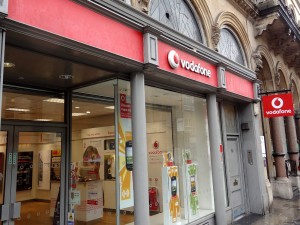 Vodafone has offered to purchase Cable & Wireless Worldwide (C&WW), with Vodafone paying 38p per share, making this deal worth £1.044bn.
Vodafone has offered to purchase Cable & Wireless Worldwide (C&WW), with Vodafone paying 38p per share, making this deal worth £1.044bn.
This deal, however, was rejected by C&WW’s largest shareholder, Orbis, within hours, as the price was not high enough, despite the 38p per share offer representing a 92% premium to the level of C&WW’s share price before the bid interest emerged in February. A spokesperson for Orbis said:
‘Although we believe the C&WW management team has handled the bid process responsibly, we have declined to give an irrevocable undertaking or letter of intent to the support the transaction.’
However, with the only other interested party, Tata Communications withdrawing, Vodafone was the only remaining bidder. As such, many suggest that this deal is a good one for the struggling business, despite Orbis’ claim that it under-values the business.
Adding a UK fixed-line cable to Vodafone’s business will increase its capacity, which is much needed at this moment in time with the added demand for mobile data from increased Smartphone usage. Cost savings are also expected from this merger, as the company will no longer have to pay to other companies to lease its fixed-line capacity.
The bid from Vodafone did help C&WW’s trading performance, which had been worsening for some time and so some shareholders will be glad of the bid. Its shares were up following this deal and it went to the top of the FTSE250. Vodafone will also benefit, as this merger would make it the second largest combined fixed and mobile line operator in the UK.
The trends of these two companies in recent years have been very much in contrast. C&WW had been the larger of the two firms up until 1999, yet the price Vodafone would now pay for the company represents a mere 1% of its current market value. The following articles consider this merger.
Vodafone bids for Cable and Wireless: The end of the line The Economist (24/4/12)
Questor shares tip: Vodafone deal looks goodThe Telegraph, Garry White(23/4/12)
Vodafone puts paid to once-revered C&WW Financial Times, Daniel Thomas (23/4/12)
Top CWW shareholder rejects sale to Vodafone Independent, Gideon Spanier (24/4/12)
CWW accepting Vodafone’s £1bn bid is a good call The Telegraph, Alistair Osborne (23/4/12)
Vodafone agrees £1bn deal for Cable & Wireless Worldwide Guardian, Julia Kollewe and Juliette Garside (23/4/12)
Vodafone agrees £1bn takeover of C&W Worldwide BBC News (23/4/12)
Questions
- Into which market structure would you place the above industry? Explain your answer.
- Which factors have caused C&WW’s worsening position? In each case, explain whether they are internal or external influences.
- What type of merger is that between C&WW and Vodafone?
- Explain some of the motives behind this merger.
- Which factors have caused these two companies to have such different trading performances in the last 15 years?
- Why was the announcement of the bid followed by better share prices for C&WW?
- Is there any reason why the competition authorities should be concerned about this merger?
“There are ‘incredible economies of scale in cloud computing’ that make it a compelling alternative to traditional enterprise data centers.” According to the first article below, cloud computing represents a step change in the way businesses are likely to handle data or use software. Rather than having their own servers with their own programs, they use a centralised service or ‘public cloud’, provided by a company such as Microsoft, Google or Amazon Web Services. The cloud is accessed via the Internet or a dedicated network. It can thus be accessed not only from company premises but by mobile workers using tablets or other devices and thus makes telecommuting more cost effective.
There are considerable economies of scale in providing these computing services, with the minimum efficient scale considerably above the output of individual users. By accessing the cloud, individual users can benefit from the low average costs achieved by the cloud provider without having to invest in, and frequently update, the hardware and software themselves.
In the case of large companies, rather than using a public cloud, they can use a ‘private cloud’. This is hosted by the IT department in the company and achieves economies of scale at this level by removing the need for individual departments to purchase their own software and servers. Of course, the costs of providing the cloud is borne by the company itself and thus the benefits of lower up-front IT capital costs are reduced. This is clearly a less radical development and is really only an extension of the policy of many companies over the years of having centralised servers holding data and various software packages.
In autumn 2010, EMC Computer Systems commissioned economists at the Centre for Economics and Business Research (cebr) to quantify the full impact that cloud computing will have over the years ahead. According to the report, The Cloud Dividend:
The Cebr’s research calculates that €177.3 billion per year will be generated by 2015, if companies across Europe’s five largest economies continue to adopt cloud technology as expected.
The Cebr found that the annual economic benefit of cloud computing, by 2015, will be:
• France – €37.4 billion
• Germany – €49.6 billion
• Italy – €35.1 billion
• Spain – €25.2 billion
• UK – €30.0 billion
Will the ability of cloud computing to drive down the costs of IT mean that a new revolution is underway? Just how significant are the economies of scale and are they likely to grow as cloud providers themselves grow in size and experience? The following articles look at some of the issues.
Articles
Reports and information
Questions
- What specific economies of scale are achieved through cloud computing?
- Why might the minimum efficient scale of cloud computing services be above the level of output of many companies?
- What are the downsides to cloud computing?
- How would you set about assessing the statement that we are on the brink of a fundamental revolution in business computing?
- Why are customer-heavy sectors, such as financial services, utilities, governments, leisure and retail, expected to buy into the concept fastest?
- How can product life cycle analysis help to understand the stages in the adoption of cloud computing?
 Many of the major industries in Australia are oligopolies/oligopsonies. Examples include banking, telecoms, supermarkets, insurance and iron ore. The dominant firms in these markets have been accused of exploiting their market power, both in charging high prices to consumers and driving down the prices paid to suppliers. The result, it is claimed, is that they have been making excessive profits.
Many of the major industries in Australia are oligopolies/oligopsonies. Examples include banking, telecoms, supermarkets, insurance and iron ore. The dominant firms in these markets have been accused of exploiting their market power, both in charging high prices to consumers and driving down the prices paid to suppliers. The result, it is claimed, is that they have been making excessive profits. 





